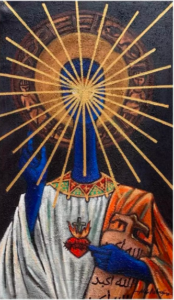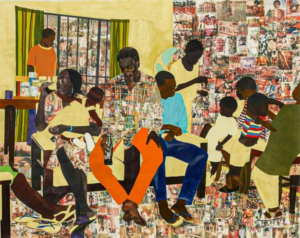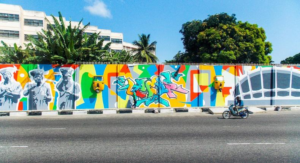The latest trends in the Nigerian art industry encompass diverse forms of creative expression such as paintings, sketches, sculptures, photography, and digital art, which is a thriving and dynamic area that showcases the talent and diversity of Nigerian artists.
The Nigerian creative sector has undergone a remarkable transformation, with painting and sketching emerging as versatile expressions of cultural evolution. Over the years, artists have embraced a plethora of techniques, styles, and themes, reflecting the rich mosaic of Nigeria’s diverse heritage.
Let’s explore the latest trends in the Nigerian art industry and investigate the current innovations that shape this vibrant landscape.
Evolution of Painting and Drawing: A Journey Through Time

Traditionally, Nigerian artists have been storytellers, capturing narratives through intricate paintings and sketches. Traditional art forms such as Nsibidi symbols and Ife bronze works laid the foundation for artistic expression, showcasing the mastery of indigenous techniques.
In the colonial era, Nigerian artists experienced a fusion of traditional and Western influences, resulting in a unique style. Visionaries such as Aina Onabolu paved the way for modern Nigerian art by blending Western realism with local themes. This marked a turning point as artists began to experiment with diverse mediums and styles.
Contemporary Trends And Techniques
In contemporary Nigerian art, a renaissance is underway, marked by a fusion of traditional and digital mediums. Artists leverage technology to explore new dimensions, creating thought-provoking pieces that resonate globally. The advent of virtual art outlets has democratized artistic expression, allowing emerging talents to showcase their work to a broader audience.
- Digital Arts
One of the most notable trends in the Nigerian artistic sector is the emergence and growth of digital art platforms, which enable artists to create, share, and sell their creations online. These platforms, such as Art X Lagos and Art House Contemporary, provide artists with access to a wider and heterogeneous audience, as well as opportunities for exposure, recognition, and income. They also offer art lovers and enthusiasts a convenient and affordable way to discover and appreciate Nigerian art, as well as to interact with the artists and the art community.
Electronic art platforms have also contributed to the development and innovation of the Nigerian artistic space, encouraging artists to experiment with novel forms, styles, and techniques, such as video games, software, e-books, and other digitalized creative content. Some examples of Nigerian digital artists who have gained prominence and acclaim through these platforms are:
- Oladimeji Alabi, creates stunning miniature paintings that capture the essence and beauty of Nigerian culture and landscapes.
 In Quest of Truth (Africanism) by Oladimeji Alabi
In Quest of Truth (Africanism) by Oladimeji Alabi - Victor Ehikhamenor, combines traditional motifs and symbols with contemporary elements and media, such as acrylic, oil, and ink, to create abstract and expressive works that reflect his identity and heritage as a Nigerian. He is also a writer, photographer, and filmmaker, and has exhibited his projects in various countries, such as the United States, the United Kingdom, Italy, and Germany.

- Njideka Akunyili Crosby, uses collage, painting, drawing, and photo transfer to create complex and layered pieces that explore the themes of identity, culture, and migration. She is one of the most celebrated and influential Nigerian artists in the world and has won several prestigious awards, such as the MacArthur Fellowship, the Prix Canson, and the Smithsonian American Art Museum’s James Dickey’s Contemporary Artist Prize.

5 Umezebi Street, New Haven, Enugu by Njideka Akunyili Crosby
- Street Art
The latest trends in the Nigerian art industry also include Street art. Street art has gained significant traction in Nigeria, providing artists with a public canvas to express their creativity and engage with diverse audiences. From vibrant murals to thought-provoking graffiti, the streets of Nigerian cities have become platforms for artists to communicate social, political, and cultural messages.
Street art in Nigeria often serves as a form of activism, addressing issues such as social inequality, environmental concerns, and cultural pride. Artists use public spaces to create visually compelling narratives that challenge the status quo and provoke conversations. This grassroots movement has not only transformed urban landscapes but has also democratized art, making it accessible to a broader audience.

- Materials And Techniques
Another of the latest trends in the Nigerian art industry is the fusion of European materials and techniques with indigenous forms and motifs standing out as a hallmark of the latest movements and advancements in the Nigerian artistic sector. This combination has given rise to a unique and distinctive Nigerian aesthetic that not only bridges historical divides but also propels the nation’s artistic expression into new realms of creativity.
Nigerian artists are increasingly exploring the possibilities offered by the integration of European and indigenous artistic elements. This trend reflects a conscious effort to reconcile diverse cultural influences, resulting in artworks that are rich in symbolism and meaning. The synthesis is not merely a juxtaposition of disparate elements but a harmonious blending that speaks to the complex identity and heritage of Nigeria.
European materials and techniques, ranging from oil paints to sculptural methods, have been seamlessly incorporated into the artistic practices of Nigerian creators. This integration allows artists to experiment with different textures, colours, and forms, pushing the boundaries of traditional mediums. The use of European materials enhances the technical aspects of artworks while providing a global context for the narratives they convey.
Simultaneously, artists draw inspiration from indigenous forms and motifs deeply rooted in Nigeria’s cultural history. Incorporating elements such as traditional patterns, symbols, and iconography, they infuse their works with a sense of identity and authenticity. The incorporation of indigenous forms serves not only as a connection to Nigeria’s rich heritage but also as a celebration of the country’s diverse cultural landscape.
- Creating A Distinctive Nigerian Aesthetic
The integration of these diverse elements contributes to the creation of a distinctive Nigerian style that transcends cultural boundaries. This aesthetic reflects the multifaceted nature of Nigeria, embracing both its historical roots and its position within a globalized world. The resulting artworks become powerful conduits for storytelling, allowing artists to communicate narratives that resonate with local and international audiences alike.
This innovative approach to artistic expression fosters a dynamic dialogue between tradition and modernity. It challenges preconceived notions about what Nigerian art should be, opening up new avenues for creativity and interpretation. The synthesis of European materials and techniques with indigenous forms and motifs not only represents a contemporary trend but also positions Nigerian art on the global stage as a lively and evolving force.
Conclusion
The Nigerian artistic sector is a vibrant and diverse area that has a lot of potential and promise for the future. The industry has shown resilience and adaptability in the face of challenges and uncertainties and has demonstrated its capacity and capability to produce quality and innovative works that reflect and represent the Nigerian spirit and culture. The domain has contributed to the global recognition and appreciation of Nigerian art.
However, the sector also faces some obstacles and limitations that hinder its growth and progress, such as lack of funding, infrastructure, regulation, and education. These challenges need to be addressed and resolved, with the collaboration and support of various stakeholders, such as the government, the private sector, civil society, and the international community. By doing so, the Nigerian artistic sector can achieve its full potential and become a leading and influential force in the world of art. The industry is proof of the creativity and resilience of Nigerians and a source of pride for the nation.

